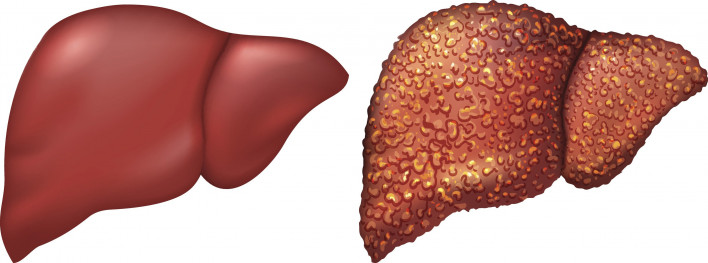Damage to the liver can be caused by many factors, hepatitis virus, non-alcoholic fatty liver disease, alcohol, drugs, and damaging environmental toxins, to name a few.
The liver is an amazing organ that has the ability to regenerate damaged liver tissue and replace with healthy tissue within limits.
In the case of Hepatitis C, in the early phase the virus can cause little to mild liver damage but over time scarring which is hardening or stiffening tissue develops in the liver. When the liver is damaged fibrous layers are formed which becomes scar tissue in the liver. This early phase of damage is called fibrosis.
Mild liver damage from fibrosis can be reversed if the cause is found and eliminated before too much damage occurs, but if scarring continues over a long period of time fibrosis becomes permanent. Damage continues to form bands throughout the liver, destroying the liver’s internal structure and destroys the liver’s ability to regenerate and impairs liver function which is cirrhosis.
Complications from liver damage (scar tissue) can interrupt liver function. Scar tissue replaces healthy liver cells which are needed to perform liver functions. Scar tissue interrupts with blood flow to the liver, without enough blood in the liver the cells die and more scar tissue is formed.
The more scar tissue is formed this can cause more severe complications.
Liver Damage can range from:
*little to mild damage
*mild to moderate damage (fibrosis)
*moderate to severe damage (fibrosis to compensated cirrhosis )
*severe to liver failure (decompensated cirrhosis)
In many cases, there are little to no symptoms with fibrosis until liver damage becomes severe enough (cirrhosis), in which the patient can experience severe fatigue, confusion, swelling in the abdomen (ascites) and legs, skin itching, and bleeding in the digestive tract, etc…
Various complications can occur from cirrhosis, the leading complication can lead to liver tumors that are cancerous, liver failure and the need for liver transplant.
Hepatitis C and Cirrhosis are the number one cause of liver transplants in the U.S.
If a virus like Hepatitis C is treated and cured early enough when liver damage is mild to moderate even with fibrosis, the patient’s liver can regenerate and maintain good liver function. Treatment and cure for Hepatitis C only stops the virus from doing further liver damage, it does not cure severe liver scarring like cirrhosis.
Cirrhosis patients will need to be closely monitored with tests and physical exams by a liver specialist like a Hepatologist or Gastroenterologist (those who specialize in liver disease). Regular blood tests, Ultrasound (sonograms), EGD, Fibroscans or MRE, MRI’s, etc…will need to be done in order to the monitor patient’s condition and evaluate a MELD score if liver transplant is needed.
This entry was originally published on Life Beyond Hepatitis C, and is reprinted with permission.








2 Comments
2 Comments